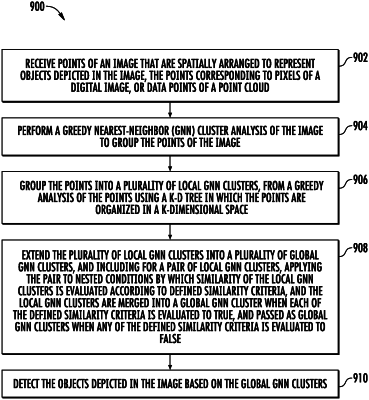| CPC G06V 10/762 (2022.01) [B64U 20/87 (2023.01); G05D 1/106 (2019.05); B64U 2201/10 (2023.01)] | 21 Claims |

|
1. A vehicle comprising:
an imager configured to convey information from which an image of an ambient environment is generated, the information including points of the image that are spatially arranged to represent objects depicted in the image, the points corresponding to pixels of a digital image, or data points of a point cloud; and
a mission management system (MMS) configured to at least:
receive the points of the image;
perform a greedy nearest-neighbor (GNN) cluster analysis of the image to group the points of the image, the GNN cluster analysis including the MMS configured to:
group the points into a plurality of local GNN clusters, from a greedy analysis of the points using a k-d tree in which the points are organized in a k-dimensional space; and
extend the plurality of local GNN clusters into a plurality of global GNN clusters, and including for a pair of local GNN clusters, applying the pair to nested conditions by which similarity of the local GNN clusters is evaluated according to defined similarity criteria, and the local GNN clusters are merged into a global GNN cluster when each of the defined similarity criteria is evaluated to true, and passed as global GNN clusters when any of the defined similarity criteria is evaluated to false;
detect the objects depicted in the image based on the global GNN clusters; and
wherein the MMS configured to group the points into the plurality of local GNN clusters includes the MMS configured to at least:
generate the k-d tree to organize the points in the k-dimensional space;
add the points to a data queue; and
iterate through the points in the data queue to group the points into the plurality of local GNN clusters.
|